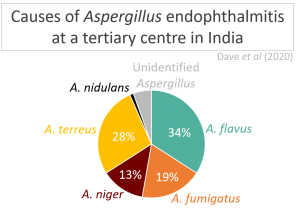Submitted by Aspergillus Administrator on 27 August 2010
Mycotoxins in our food is not something people in the developed world hear much about. We have our basic food hygiene and a natural innate distaste for eating mouldy food that protects us, and we have a rigid food testing regime that ensures we do not have significant mycotoxin contamination of the foods we buy from producers. But how much are we exposed to and how often?
Bearing in mind that foodstuffs intended for animals are of a lower quality than food intended for human consumption, so mycotoxin prevalence is far more likely to be widespread, this survey is still quite striking. Also bear in mind that the company undertaking this survey seem to be involved in providing mycotoxin management services to the producer, so do have a vested interest in emphasising the positive!
There are five toxin groups surveyed; aflatoxins (Afla), zearalenone (ZON), deoxynivalenol (DON), fumonisins (FUM) and ochratoxin A (OTA) which are produced in the main by three different fungi; Aspergillus, Penicillium and Fusarium. Most strikingly the number of samples testing as positive (see map for regional variations) vary from 28% (OTA) to 56% (FUM) – a very large proportion, leading to the natural conclusion that most food animals are feeding on mycotoxins most of the time. The terms of reference for the producer are of course how this would impact the wellbeing of his stock animals, there is no attempt to record the levels of mycotoxin in the resulting meat & other products in this survey.
NB Mycotoxin levels in food derived from animals is strictly controlled throughout the developed world – see Foodrisk.org, so we could conclude that although animal feeds are frequently contaminated by mycotoxins, those mycotoxins are not passed down through the food chain to us at levels thought to do us harm. The safe levels set seem to be largely based on tests on laboratory animals eating large amounts of toxin and laboratory experiments on human cell lines- see toxicology.
It is also mentioned in this survey that more than one mycotoxin was found in many samples, and it is implied that this may well increase the harm to the stock, though no evidence is referred to to back this up. This is a poorly understood subject for both animal and human food.
Chronic low level exposure to mycotoxins is starting to be defined on an international scale, cheap, consistent testing is being developed and international regulations harmonised. There are some reports of health problems (link) but this is still a poorly understood area of some concern (link).
Overall the levels of mycotoxins we are exposed to in our food is under strict control in developed countries, but there are still poorly defined risks with serious difficulties tracing the results of an exposure that might not emerge until several years later. We cannot regulate our own exposure on a personal level as we cannot know what foods we eat contain mycotoxins, all we know is that some are likely to contain mycotoxins at low levels and that as far as we can tell there are no major health effects from eating our food. Much more research is needed to define these risks.
News archives
-
Title
Date



